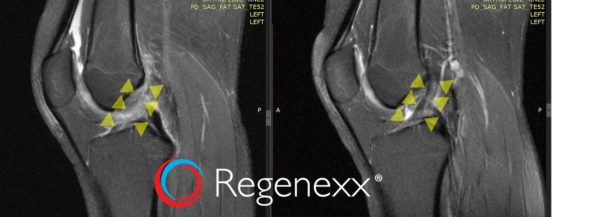Does a Torn ACL Require Surgery?

©Renegexx
Does a torn ACL require surgery? Not according to these before and after MRIs showing ACL healing that are now getting pretty routine around our clinic. Orthopedic surgeons aren’t happy about it all, as ACL reconstruction surgery is like a sacred cow crossing the road in India—it’s the one procedure that defines modern orthopedic sports medicine. Based on what we’re seeing every day in the clinic, most of these invasive surgeries should be replaced by precise stem cell injections.
Lydia’s Story
Lydia is an active 14-year-old high-school student who plays volleyball. She had a ski injury in December with a subsequent reinjury of her knee while performing jump squats in volleyball. Her knee MRI showed a complete ACL tear. Treatment consisted of a brace and physical therapy, and she was told she would need an ACL reconstruction surgery. In February, Dr. Schultz performed the precise image-guided placement of her own stem cells into the ligament, using our patented same-day injection procedure (without surgery). Above is her three-month postinjection MRI. On the left the MRI shows few visible ACL fibers (yellow arrows), and on the right it shows an ACL that now has some substance (yellow arrows) but still needs additional work.
Where Should Lydia Go from Here for the Best Chance of Fully Healing This ACL?
First, based on our extensive experience with stem-cell-based ACL healing, we know the following:
- Lydia’s ACL was a challenge to start with in that there were fewer visible fibers than in our typical stem-cell-treated complete ACL tears.
- At her age, it’s often possible to see complete healing at three months (which doesn’t generally happen in older patients as quickly).
So we know, based on experience, that this three-month result needs more work if she’s going to end up with a robust ligament. Hence Dr. Schultz advised her to get a second procedure. How many patients need a second full stem cell procedure or other injection to help healing? About one in three at this point.
So does a torn ACL require surgery? We now have many, many before and after MRIs showing imaging progression of torn ACLs toward healing after the ACL stem cell procedure we invented (many images are on this blog). We’re seeing even more MRI evidence of ACL healing now that we have again advanced our stem cell placement techniques. Hence, the prima facie evidence we see every day argues that most ACL surgery will soon be a thing of the past, relegated to the dustbin of medical history. When will that happen? Given that we now have allowed a nonprofit to begin teaching other physicians this advanced ACL stem cell technique, hopefully sooner rather than later.
The upshot? ACL surgical reconstruction will likely end up being an interesting point on the timeline of the history of orthopedics. A place where medical students 50 years hence look back and say, “What were they thinking?” To them the question of “Does a torn ACL require surgery?” will be as ridiculous to us as “Does an infection require bloodletting?” Why? Even the ACL tears we can’t heal today with this technique will likely be fixed in the future through a small needle, using advanced biologic techniques to regrow the ligament and not arthroscopic surgery to drill holes and install a tendon!

If you have questions or comments about this blog post, please email us at [email protected]
NOTE: This blog post provides general information to help the reader better understand regenerative medicine, musculoskeletal health, and related subjects. All content provided in this blog, website, or any linked materials, including text, graphics, images, patient profiles, outcomes, and information, are not intended and should not be considered or used as a substitute for medical advice, diagnosis, or treatment. Please always consult with a professional and certified healthcare provider to discuss if a treatment is right for you.